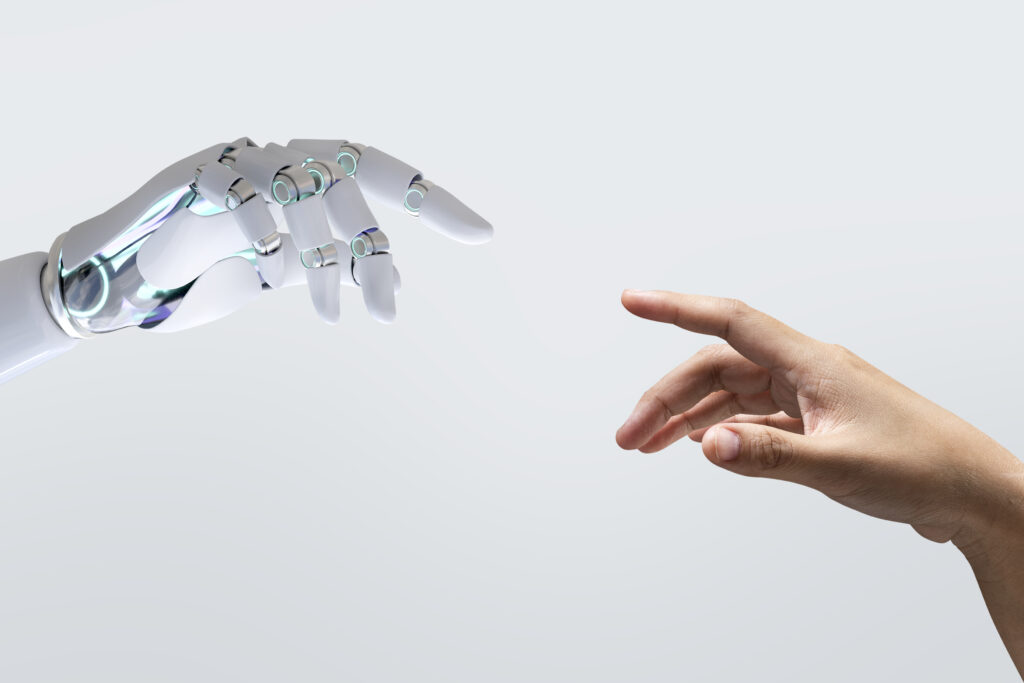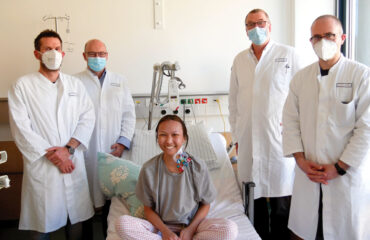By Mariana Meneses
In a groundbreaking medical first, a baby in the United States has been treated with a personalized CRISPR gene-editing therapy to correct a rare and life-threatening genetic disorder. This technological feat opens the door to treating a range of debilitating conditions, although its potential for abuse raises many serious ethical concerns.
KJ Muldoon, now over 9 months old, was diagnosed shortly after birth with CPS1 deficiency, a condition that prevents the body from eliminating certain toxic metabolic waste and often leads to liver failure or death. With limited options, doctors at the Children’s Hospital of Philadelphia proposed an unprecedented approach: using CRISPR-Cas9, a Nobel Prize-winning technology, to edit KJ’s specific genetic mutation. KJ’s parents agreed to the experimental treatment, which involved infusing his body with a gene-editing therapy custom-built for his unique DNA.
The therapy worked like molecular scissors, traveling to KJ’s liver to fix the faulty gene responsible for his condition. While the treatment is still under long-term observation, early results are promising, as KJ can now tolerate more protein in his diet and requires less medication. His care team hopes this pioneering case will open doors to similar personalized treatments for others with rare genetic conditions. Although KJ will need regular follow-ups, doctors are optimistic that he may eventually live with little or no ongoing medication, and that his case could set a precedent for a new era of individualized medicine.
But as the promise of gene editing unfolds at the therapeutic level, reproductive technologies are expanding the conversation to include not only treatment but also selection.
A new technological frontier has emerged: polygenic embryo screening. Unlike traditional tests that identify rare single-gene disorders, this technique offers assessments of the probabilities of complex issues such as heart disease, depression, intelligence, and even height. In an article published in The New York Times, journalist Anna Louie Sussman explores how companies like Orchid market these services as a path to “healthy babies,” by selecting embryos based on genetic profiles derived from massive (and often demographically skewed) datasets.
While pitched to reduce suffering, the technology quickly blurs into enhancement, and the ethical terrain becomes far more uncertain.
Sussman follows parents, investors, scientists, and bioethicists navigating this landscape. Some, like tech-savvy couple Simone and Malcolm Collins, embrace the technology as a form of “procreative beneficence,” aiming to reduce future suffering by selecting embryos less likely to inherit conditions like depression or cancer, and more likely to exhibit traits like low anxiety and high intelligence. Others worry about the social consequences of such choices.
Embryos are increasingly treated not as potential children but as data sets to be optimized. The lack of regulation in countries like the U.S. has led to a marketplace-driven approach, where companies offer services like IQ screening under the radar and clinics market time-lapse videos of embryos as “baby’s first photo,” anthropomorphizing cell clusters to create emotional bonds and social legitimacy.
Meanwhile, researchers are also pushing the boundaries of what gene editing might achieve after birth, particularly in the brain.
Researchers from China have recently published an article in the peer-reviewed journal Gene. In it, researchers led by Wenzhou Medical University’s Xiuying Gao discuss how gene editing is opening new possibilities for treating neurological diseases that currently have no cure, such as Alzheimer’s, and Parkinson’s. This review outlines how scientists are moving beyond older gene therapies, which typically inserted healthy genes without fixing the faulty ones, toward next-generation tools that can precisely rewrite parts of a person’s DNA or RNA. These newer methods, like base editing, can correct single genetic “letters” without breaking the DNA strand, making them more accurate and potentially safer. Such precision is especially valuable in the brain, where unintended effects can be especially serious.
While most of these techniques are still experimental, their ability to directly target the root causes of neurological disorders signals a shift toward more personalized and effective treatments. As the technology continues to evolve, it may help transform how we approach some of the most complex and difficult-to-treat diseases and conditions.
Another major frontier is cardiovascular health.
A 2025 peer-reviewed study published by Quan Duy Vo, from the Okayama University in Japan, argues that gene editing therapies are emerging as a promising approach to treat cardiovascular diseases (CVDs) by directly targeting the genetic causes of conditions like high cholesterol, cardiomyopathies, and arrhythmias.
This review analyzed 57 preclinical studies using animal models (mostly mice) to evaluate the safety and effectiveness of tools like CRISPR-Cas9 and base editors. Unlike CRISPR-Cas9 systems, which rely on cutting DNA to induce repairs, base editors directly convert one DNA base into another, offering a more targeted and potentially safer approach for correcting genetic mutation.
Most of these studies achieved gene editing efficiencies between 25% and 85% in the heart and liver. The most common delivery methods were adeno-associated viruses (AAVs), known for their high efficiency, and lipid nanoparticles (LNPs), valued for their safety and flexibility. Results showed that even modest levels of editing often led to significant improvements in heart function, cholesterol reduction, and survival, with low rates of side effects or off-target mutations.
Though test results in animals are encouraging, challenges remain before these therapies can become routine treatments for humans. Key issues include how to deliver the editing tools safely to the right tissues, ensure long-term safety, and make these therapies accessible and affordable.
Base editors showed fewer unintended edits than CRISPR, and new tools are being developed to improve precision and reduce risks. Several gene editing treatments for cardiovascular conditions are already being tested in early-phase human trials. If successful, these therapies could shift the paradigm from lifelong symptom management to one-time, potentially curative treatments, but only if ethical, technical, and economic hurdles can be carefully addressed.

“Cardiovascular diseases are the leading cause of death globally, taking an estimated 17.9 million lives each year” (The World Health Organization). Image: Freepik.
The accelerating convergence of biology and computation is also reshaping how discovery itself happens.
In January 2025, MIT Technology Review reported that ChatGPT-maker OpenAI had entered the field of protein engineering with a custom-built model named GPT-4b micro. Unlike Google DeepMind’s AlphaFold, which predicts protein structures, GPT-4b micro is designed to generate new protein sequences and suggest specific modifications to improve biological function.
In partnership with Retro Biosciences, a longevity-focused startup funded personally by OpenAI CEO Sam Altman, the model was tasked with optimizing Yamanaka factors: proteins known to reprogram adult cells into stem cells. Though powerful, these factors are notoriously inefficient. GPT-4b micro proposed new versions of two Yamanaka proteins, and early lab tests showed they were over 50 times more effective.
Rather than testing every possible combination manually, which is a virtually impossible task, researchers used few-shot prompting to guide the model in generating functional variations, many of which involved altering a third of the amino acids. “Few-shot prompting” is a technique in natural language processing where a large language model is given a small number of examples to guide its response to a specific task. It’s a method that sits between zero-shot learning (which is learning with no examples) and fully supervised fine-tuning.
According to Retro, these AI-designed proteins consistently outperformed human-designed counterparts. While the results are still preliminary and not yet peer-reviewed, the project illustrates how large language models like ChatGPT might accelerate biological discovery. It also raises ethical questions.
Sam Altman is both CEO of OpenAI and the main investor in Retro, prompting scrutiny about the blurred lines between AI development and private biotech ventures. OpenAI has stated that no money changed hands in the collaboration and that Altman was not directly involved in the research, but the case underscores how scientific advancement is increasingly shaped by overlapping corporate interests, and how breakthroughs in AI may soon ripple through biology, medicine, and beyond.
As gene editing technologies mature, so too do the ethical questions they raise.
In his 2025 thesis Navigating the Ethical Implications of Human Gene Editing Technology: A Comparative, Multi-Perspective Approach, Baylor University’s Samuel Decker explores these complexities through a comparative analysis of three prominent voices: bioethicist John Harris, philosopher Michael Sandel, and theologian Celia Deane-Drummond. At the heart of the debate is the power of CRISPR-Cas9, which is remarkable for its precision and therapeutic potential but also fraught with risks, especially in germline editing that affects future generations. Decker outlines not only the promise of gene editing for conditions like cystic fibrosis and cancer but also the unknowns: off-target effects, regulatory gaps, and the specter of long-discredited eugenics disguised as progress.
Harris defends gene editing from a utilitarian and secular standpoint. He argues that if science can reduce suffering or extend life, society has a moral obligation to pursue it. He champions individual autonomy and even endorses enhancement, suggesting a future of optimized, longer-living humans. But Decker cautions that Harris’ optimism neglects long-term social risks and philosophical depth.
In contrast, Sandel urges humility. For him, the issue is not technical capability, but moral posture: he argues that manipulating human traits could undermine solidarity and shift how we value each other, not for who we are, but for how we’ve been engineered.
Deane-Drummond brings a theological dimension grounded in Christian virtue ethics. She embraces therapeutic use but insists on values like justice, prudence, and humility. Rather than rejecting enhancement outright, she frames the conversation around human dignity and relational responsibility.
Decker ultimately proposes a blended ethical framework: one that integrates Harris’ focus on alleviating suffering, Sandel’s call for humility, and Deane-Drummond’s virtues-based approach. He closes by calling for global regulation, equitable access, and a moral compass that asks not just can we edit life, but why, for whom, and at what cost.
Ethical frameworks may guide the conversation, and science may set the stage, but it is the public perception, rooted in emotion, identity and belief, that shapes what society will embrace or resist.
A 2025 study published in the peer-reviewed journal Ethics, Medicine and Public Health, by Z. Altinay from the University of Nevada, investigates how people’s trust in science and their ethical concerns, especially about “crossing boundaries”, shape their acceptance of human gene editing (HGE). Using a secondary analysis of a large-scale U.S. public opinion survey with over 5,000 participants, the researcher found that while many individuals express support for science and its benefits, their acceptance of specific technologies like HGE depends on how such innovations are perceived in moral and symbolic terms.
For example, editing human genes to treat severe diseases tends to be more accepted, but when it comes to enhancements or inheritable changes, acceptance drops sharply. The concept of “boundary crossing” (i.e., intervening in nature in ways that feel unsettling or unnatural) emerged as a central factor.
People are often uneasy not because of concrete risks but because gene editing challenges deep-seated beliefs about what is natural, moral, or within human authority. These concerns are amplified when HGE is seen as “playing God” or disrupting the natural order, especially in contexts shaped by religious or culturally rooted views on purity and sanctity.
In Altinay’s view, people’s views about what science should do matter as much as what it can do, especially when it comes to altering the human genome.
Yet another critical question remains: Who is gene editing being designed for?
While debates often focus on ethics or safety, they can obscure another longstanding blind spot in medical research: its failure to account for global genetic diversity. A striking reminder comes from Brazil, where researchers have uncovered over eight million previously undocumented genetic variants. This not only reveals how much we still don’t know about the human genome, but also shows why inclusive research is essential before genomic editing.
Led by the University of São Paulo’s Kelly Nunes, the Brazilian team of researchers have recently published a groundbreaking study in the peer-reviewed journal Science. It provides the most comprehensive look to date at the genetic diversity of the Brazilian population, which is uniquely shaped by centuries of admixture among Indigenous peoples, Europeans, and Africans.
Researchers sequenced the entire genomes of 2,723 healthy individuals from diverse Brazilian regions and backgrounds, including rural, urban, and riverine communities. The result was the discovery of over 8 million previously undocumented genetic variants, 36,637 of which may negatively impact protein function and potentially influence health. The study fills a major gap in genomic research, as populations in the Global South, especially in countries like Brazil, have been vastly underrepresented in genetic studies, despite their complex and informative demographic histories.
The team traced the timeline and geographical spread of admixture events, finding that most occurred between the 18th and 19th centuries, aligning with Brazil’s colonial and postcolonial history. The data revealed patterns of mating initially dominated by male European colonizers intermixing with Indigenous and African women, followed by more recent trends of assortative mating, when individuals choose partners with similar ancestries.
The researchers also identified regions of the genome that show signs of natural selection, particularly genes linked to immunity, metabolism, and fertility, traits that may have offered adaptive advantages in different environmental contexts.
Importantly, the study shows that certain deleterious mutations are more likely to occur with specific ancestral lineages, suggesting that population-specific risk factors may shape health outcomes. This reinforces the need for inclusive genomic databases that better represent admixed populations, which refers to the processes of genetic mixing between previously isolated populations. As precision medicine grows globally, relying on data from Eurocentric populations alone risks deepening health disparities.
Public trust in science is conditional, contested, and shaped by deep-seated beliefs about identity, fairness, and the limits of human authority.
As the U.S. survey analyzed by Z. Altinay shows, even those who support science in principle may reject gene editing if it feels like a step too far, especially when it challenges moral boundaries or fails to reflect shared values. KJ Muldoon’s story reminds us of what’s at stake: not only the life of one child, but the future of medicine itself.
As gene editing advances from rare disease treatment to embryo selection, brain research, cardiovascular repair, and AI-guided protein design, the power to reshape biology is becoming both more precise and more personal. But technological precision is not the same as ethical clarity, and innovation without inclusion risks reproducing old hierarchies in new genetic code.
Who benefits, whose bodies are studied, whose values are honored? These questions must remain at the heart of our decisions. To move forward responsibly, the future of gene editing must be as diverse, deliberative, and humane as the human genome it seeks to rewrite.
Craving more information? Check out these recommended TQR articles.
- Thinking in the Age of Machines: Global IQ Decline and the Rise of AI-Assisted Thinking
- Everything Has a Beginning and End, Right? Physicist Says No, With Profound Consequences for Measuring Quantum Interactions
- Cleaning the Mirror: Increasing Concerns Over Data Quality, Distortion, and Decision-Making
- Not a Straight Line: What Ancient DNA Is Teaching Us About Migration, Contact, and Being Human











